Tale as old as time is the debate about what is more important in order to achieve a certain marketing goal: quality of the creative or targeting. The most truthful answer is that both should be done well! A good steering and placing of your campaign in the most suitable environments/slots and in the best channels, with as little as possible scatter loss, is one of the goals. Equally important are excelling in the creation of an effective creative, packing it in the right form and getting your message across.
Notwithstanding, ad creation is not a one-way street. There are various opinions on what works and what does not, and marketers, market intelligence gurus and art directors are constantly on the hunt for new inspiration. A vital strategic question upfront is also what topic the creative should have in order to generate high return on investments.
Given the saturation of sports events in 2021, the upcoming winter Olympic games and the FIFA World Cup in 2022, 'sports' as a topic has certainly landed on the whiteboard or is on the radar of many. If not on your professional agenda, sports surely has entered your homes and was on TV or other devices. Why have advertisers chosen it? Sports has the unique power to motivate, challenge, unite, pacify and engage, which is undeniable. It is present in our daily life; it is a passion and a dream for millions of people. Given its popularity and positive vibe it enables communication with the audience at an eye level. But is that so straightforward! Here a few questions we asked ourselves:
- How about 'sports' as a central theme of an ad campaign? Does it pay off in leveraging the brand and what does it actually achieve?
Background
To answer these relevant questions and give recommendations for future contemplations on whether to go with a sport-related ad, Kantar combined their Analytics and Creative capabilities and investigated the effectiveness of a number of TV campaigns around sports events. We have gathered 46 ads across markets (Netherlands, Belgium, France and Italy) which are focused on either the UEFA Euro 2020 (2021), the UEFA Nations League or the Olympics and Paralympics in Tokyo.
The storylines are varied e.g., some plot around the company's sponsorship of an individual sportsman, others touch upon the patriotic feeling of the audience and still others — on promoting a call-to-action or a new product. Multifaceted are also the zoomed-in ads when it comes to length, tonality, tempo, mood, characters, voice over, ad claim, type (brand new or continuation of an existing campaign), etc. as well as the brand itself – its category, size, market position, price class. Therefore, our multiple-case-study design has good variability as a foundation and projects a broad reality out there.
Methodology
In order to analyse and compare the questioned ads at scale and real-time, we have run them in our creative performance assessment AI tool, called Link AI.
- Link AI is Kantar's machine learning platform for testing TV and digital creatives which provides trusted results within 15 minutes, tapping into a validated database of more than 200K quantitative copy-tests gathered across the globe in the last years and ongoingly.
It is a new product, founded in the vast expertise of years of survey data with an AI layer in its core that predicts the resonance of an ad, assessing its in-market performance as humans would do. Link AI delivers the analysis in an easy-to-use interactive dashboard. Here how it works in a nutshell:
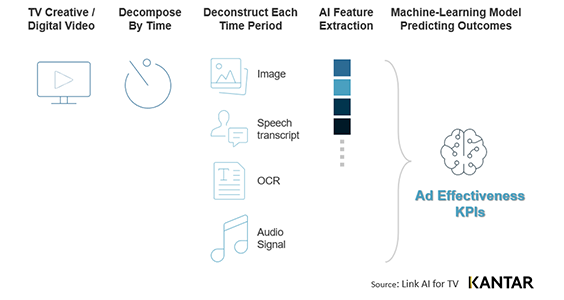 Topline results
Topline results
Now, putting the how aside, let us dive into the results as they are the most interesting part here. Overall, what we have found out is that these adverts really excel in involving the viewer into the story. Sport-related ads hit over 33% higher involvement than ads aired in other contexts. They take you by the hand and engage you with the narrative creating sentiment to the delivered message. Along with that most of them are impactful. So, it can be concluded that consumers are quite receptive to sport-events ads when the whole atmosphere 'breathes' sports. Compliments for that!
On the other hand, averagely, ads around sport events score below the brand performance of regular ads! This is a natural outcome given advertising is much about consistency, whereas advertising around sports is rather playing in an uneven game for most of the brands. Why is that? Consumers get stuck in the middle of so many ads bombarding with scattered sport-related messages evoking an even more twisted paradox of choice. That translates into lack of understanding, nonlinear stories and less persuasive claims, which at the end of the day influences the success of the ad to improve brand predisposition.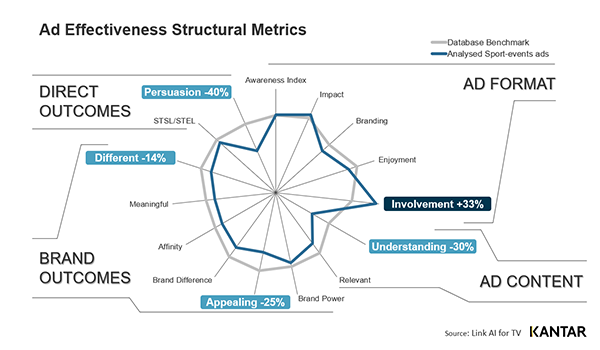 Looking at the few successful examples in the batch of sport-event-related ads that do manage to leverage their brand power (long term brand equity effect), boost awareness or sales likelihood, a few topics come up: :
Looking at the few successful examples in the batch of sport-event-related ads that do manage to leverage their brand power (long term brand equity effect), boost awareness or sales likelihood, a few topics come up: :
- These ads succeed in standing out as different from the rest. They are distinctive, one-of-a-kind!
- They mean something to the viewer. They create affinity for the brand and the perception that the brand is touching upon real needs — their needs.
- Most score well on branding, namely they inspire a consistent relation with the overall brand positioning.
- They tend to do better when they engage quicker with the audience, catching people’s attention through a clear introduction of characters and the micro-quest within the ad storyline.
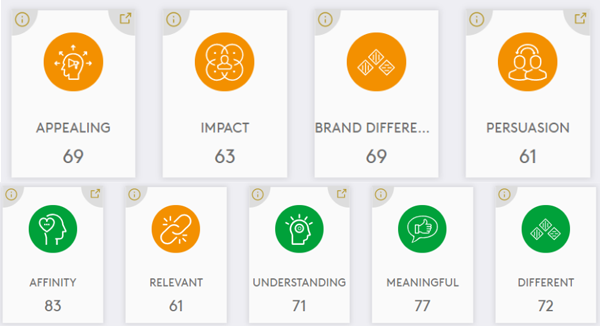
On the whole, engagement KPIs like involvement are above the benchmark, but not brand building ones, such as brand power. In order to boost the latter your brand's creative should be two things meaningful and different. That is clear! Now, how can you accomplish that?
Best practices for effective creatives around sports events
Here three recommendations stemming from the most successful ads that get the green light for their overall performance in our Link AI study:
1. Give your brand or product an active and clear role in the narrative, make it a main character in the plot
The best performing ads when it comes to brand power boost are the ones incorporating their product into the narrative rather than the ones explicitly detaching the brand. By doing so they make the connection between the ad and the brand more straightforward and so the brand gets closer to the viewer. We, the consumers, are ambiguity averse, thus we tend to favour known, clearer things. At least that is what behavioural economics preaches and what we validate in Kantar's Link AI tool results as well. E.g., ads with famous sportsmen practicing 'their' sports outperform on all metrics benchmarked against examples where they do something different, unusual for them.
Furthermore, often effective ads depict scenarios where we can place ourselves or which resonate with us. So, either they picture a normal part of daily life and/or invite you into their world of sports achievement, spirit, teamwork, strength, endeavour, stamina, tears, wins and losses and all that right from the couch. For instance, cheering the national football team when they win, doing laps in a pool during a contest, ordering the pizza after a busy day, doing grocery shopping, smearing spread on your slice of bread or scrolling Instagram. They bid either on depiction of reality or showing another world, going for escapism. For brands that do not have an obvious functional connection to the events, they should work with different storytelling to achieve the result! What the findings show is that funny and patriotic ads score best.
The idea is to get the consumer into the 'flow' so that they immerse into the plot and to make them forget that bottom line someone is trying to sell something right this minute. On the contrary, if we are placed as spectators into the position of having a problem or a demand, wanting to satisfy a craving or to get pleasure from something, the brand/product should give us the means to do that. Then this brand is not trying to sell us something but is helping us get what we want and what we need. It is doing us a favour!
Therefore, regardless of the context and the level to which you want to take the viewer on an everyday trip more connected to your brand or send them on more of an exotic journey, remember and put in practice the following:
- Takeaway: therefore, regardless of the context and the level to which you want to take the viewer on an everyday trip more connected to your brand or send them on more of an exotic journey, remember and put in practice the following: Make sure the brand and product are intertwined in the story! Make sure there is a clear connection between the two!
2. More concrete ad claims rather than general messages matter
Most of the sport-related ads we researched aim at increasing general interest. There are few which have a clear call-to-action, announce a promotion or introduce a new product, variant, or line extension. So, when you sit on your couch during the commercial break on the UEFA Euro 2020 (2021) Championship you are swamped with numerous advertisements with no clear takeaway. In this constellation of sports on air and sports most of the time during the break, the general campaigns seem not to stick really. They are too far away, not relevant and credible. The message is blurred in this sea of claims. Potentially, it might be because watching sports is a very active activity and the advertisers should carry on and engage the active mind in the break too.
- Takeaway: use more concrete claims and clear messaging in sport-event-related ads. Spark conversation with your viewer and give them a coherent takeaway to remember!
Below are a few examples of well-performing campaigns which manage to boost not only the engagement but also the branding metrics. The first one has been aired in both Dutch and French in Belgium and the other two were part of the sports offensive in the Netherlands.
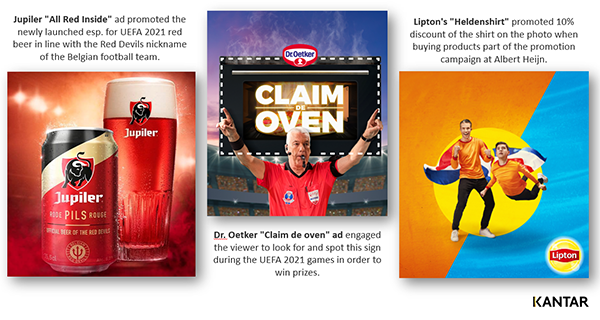
The Jupiler 'We're all red inside' campaign focuses on the introduction of the new red beer with taste remaining the same consumers are used to. A number of football players from the Belgium national team are included and overall, the patriotic card is played. Still, the ad is dynamic, upbeat and not long, starting a bit dramatic with the hint of COVID lockdowns and finishing on a positive note. It gives hope and energises!
There are multiple brand cues present in the ad and clear consistency with showing the emblems of the Red Devils — the brand logo on TV, on posters, the logo of the team, the shirts of the players and their familiar faces as well as exhilarated fans. Occasional or environmental cues like pouring beer from the draught or watching a game with a bottle in your hand as well as a cultural cues like the red-yellow smoke on Grand-Place de Bruxelles, all place the viewer in a familiar, relatable atmosphere and convey the message of the 'known, familiar, home-like'. Throughout the creative 'Tous Ensemble!' is chanted, evoking the feeling of what it actually means in French 'All Together' and affirming a hedonic goal. At the end of the day, this is a make-feel-good ad. And who does not want to feel good?
3. In a sea of competitors with similar ads in an analogue environment, find your angle to stand out
The most prominent ads in our study excelling in driving brand predisposition growth, have one thing in common when a content analysis is done. All these ads do stand out – they are distinctive and interesting. Their novelty stems from a unique way of including their product into the ad or creating a plot that is totally different than what the rest of your competitors have in stock or simply the ‘’action’’ promoted goes beyond 'buy my product'.
Sport contests invigorate and fill the audience with positivism, they include local heroes and celebrities, often offering alike giveaways as last season/contest or having a similar story. Beware that a big part of the analysed brands' ads, for instance, attempted to touch a patriotic note e.g., with 'oranje' claims. This could be repetitive if most of the ads on the spectrum go for the same and there is nothing to differentiate them from the rest. We would like to argue that brands could think a bit further.
Besides showing the event, or national pride, they can think of unique, unforeseen scripts. E.g., yes, you can promote a Louis Vuitton in the classical fashion-related plot. Or, as we have witnessed, you can sponsor a sport event in which the trophy is brought to the winners' podium and taken out of a Louis Vuitton bag. Same trick can be applied in an actual ad. This type of nudging shifts salience in an elegant way putting not the brand or product totally in the foreground but rather subtly hinting about it, making it become integral for the story.
- Takeaway: to be ahead of the competition, come up with a way your brand or product is integral to the story but more between the lines than putting it drastically and bluntly in the foreground.
Wrap up
If you decide to go for the creation of an ad with a story around a sport event, make sure, more than ever, to make a narrative which stands out and create a relatable ad with a meaningful message!
The consumer is bombed with similar content and each sponsor asks for their attention, so being able to tell your story apart aids memorability and is vital for success. Further on, this will guarantee that the ad will contribute to long-term brand equity. And isn't that the real all-time goal behind advertising?
Furthermore, important to keep in mind is that most often, the advertised brand is not a sports brand per se. Going for sports takes a long time to establish, show results and reap rewards subsequently. It is unlikely to get short-term sales uplifts and ROI as a result of a sport-events ad. Dedicate resources and focus on measuring and understanding what power supporting sports has on your brand building. Make sure that there is a legitimate connection between the brand and its sponsorship modality. Being present with sports creatives throughout time, will guarantee better outcome from sports ads during relevant sports events.
How can Link AI help with your business questions?
- Batch testing high volumes of ads to use for meta-analysis
- Versioning – e.g., different time formats, CTAs, offers, prices
- Screening ads for smaller/local brands that wouldn’t normally be tested
- Quickly choose between options when receiving ads from abroad
- Test ads of competitors
Does that sound interesting, does it ring any bells? Eager to know more?
Click on this video to get a better idea of Link AI:
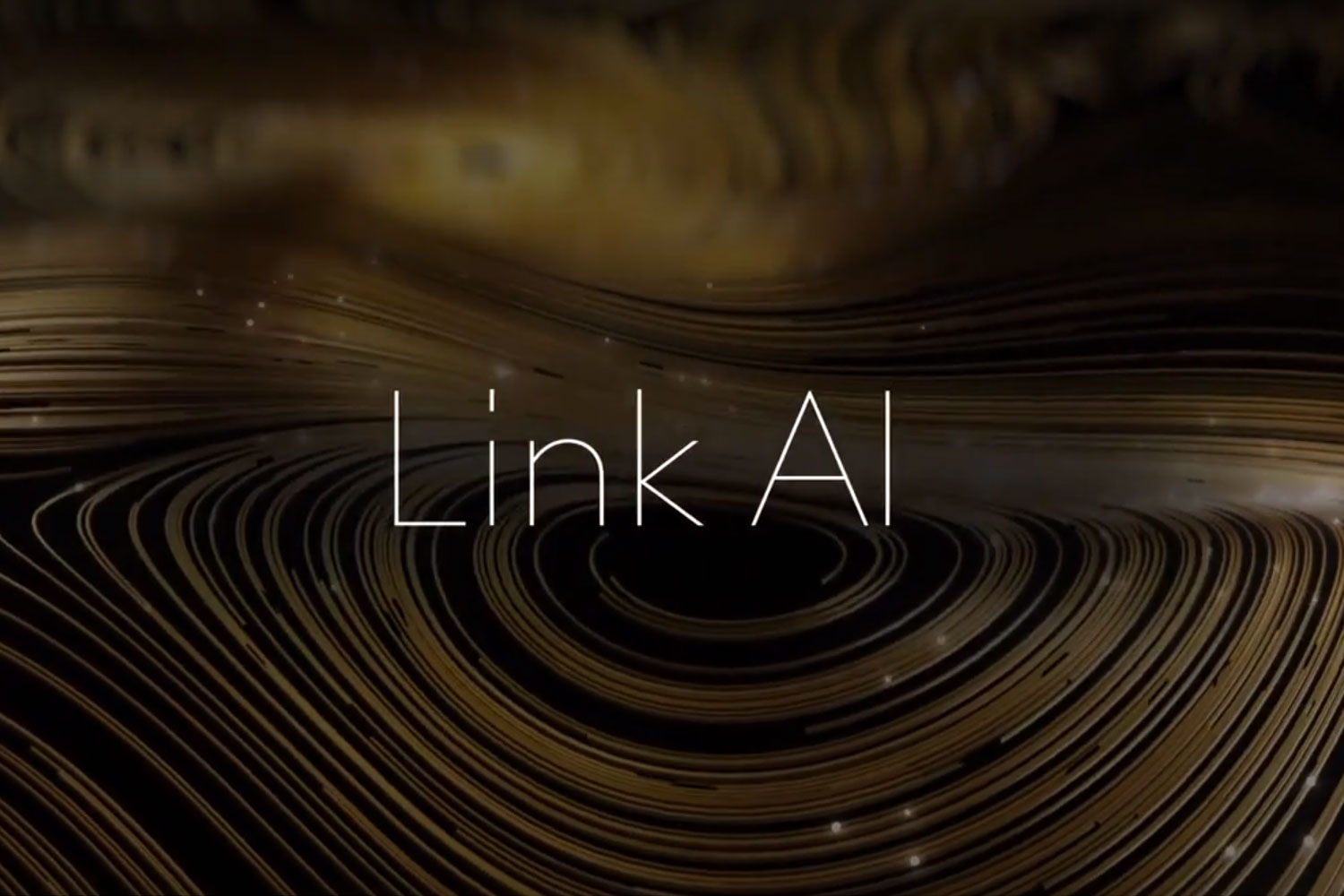
Check also our website and get in touch with your Kantar Account manager for a short demo and to discuss your specific business questions. Or gladly with me, Inna Ivanova-Genova, Analytics consultant, at inna.ivanova-genova@kantar.com and with our Head of Analytics in the Netherlands, Iris Houtepen at iris.houtepen@kantar.com.

